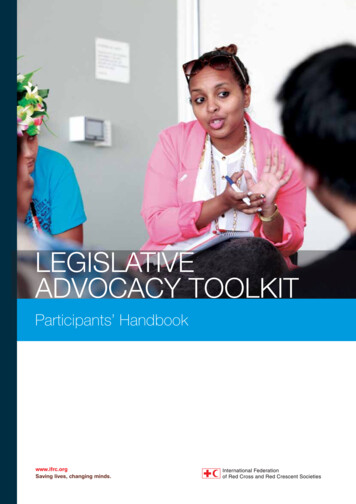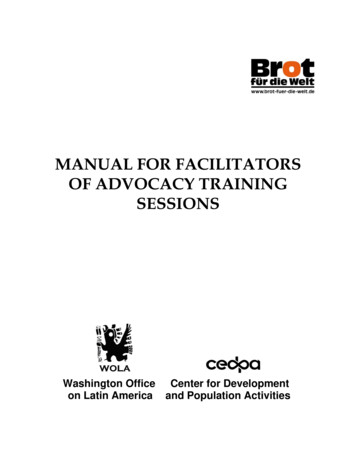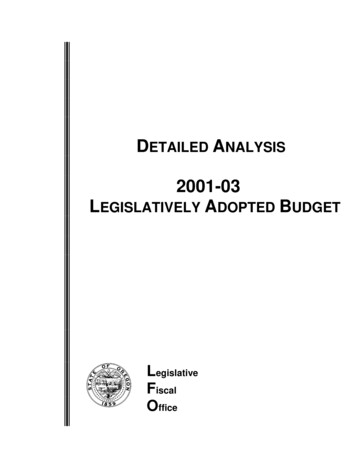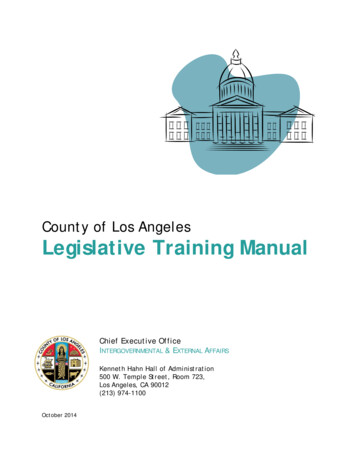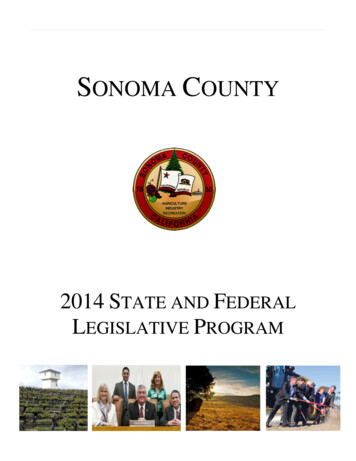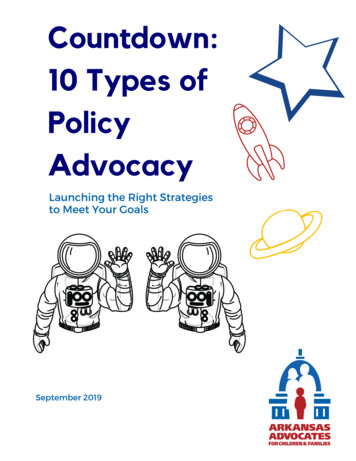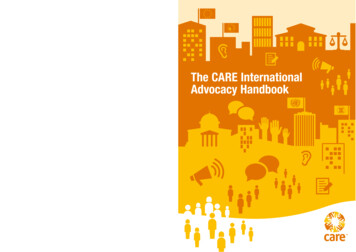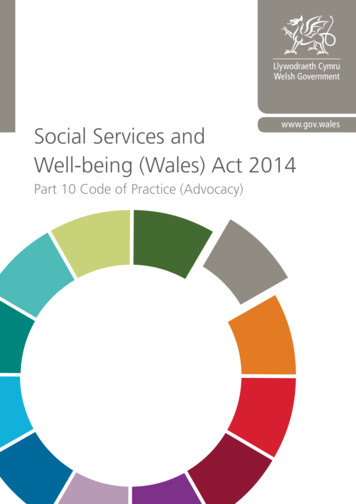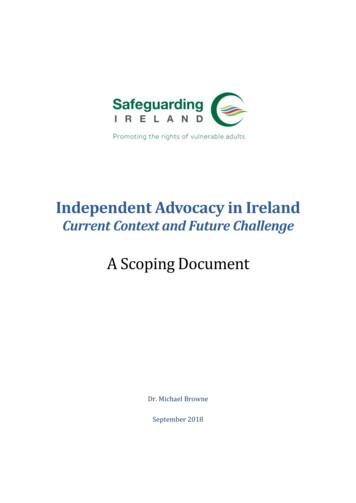
Transcription
Legislative Advocacy 101Ally Kayton, MSN APRN NNP-BCVicki Leamy, DNP NNP-BCPresented by the NANN Health Policy & Advocacy Committee
Objectives To teach NANN members how to effectivelybecome active in legislative advocacy withconfidence To increase awareness of pertinent advocacyissues and opportunities2
Goals Expose our members to current legislativeefforts, issues, and needs surroundingneonatal legislative efforts. Teach techniques for researching currentlegislative issues that pertain to neonatalmedicine. Provide a forum for our members to share theirwork on current issues, legislation, andadvocacy efforts.3
Additional Goals To foster awareness about legislative advocacyamong NANN/NANNP members within theirstate and local communities.WHILE Empowering NANN/NANNP members to beactive advocates for children’s health issues,both now and in the future.4
The Three A’s of Advocacy Awareness Your own, friends, family, colleagues, legislators. Advancement By getting involved, you can help advance amovement or effect a policy change. Action Make contacts, write letters, call or visit yourelected officials, support an organization.5
Why should we be advocates? Babies cannot advocate forthemselves We have a unique position tosee problems and understandtheir implications The problems matter We have “respect” and“credibility”6
Advocacy in Action Advocacy is one of four major goals for theassociation Make an impact on neonatal nursing practiceregulation and policy and the health ofneonates and their families Monitor progress on key issues and seekopportunities to work in coalition with otherhealthcare-related groups that share its ideals7
CollaborationCollaborating together with our national nursingorganization partners on advocacy issues fornurses, nurse practitioners and clinical nursespecialists American Nursing Association (ANA)American Academy of Nurse Practitioners (AANP)American Association of Critical Care Nurses (AACN)American Association of Colleges of NursingMarch of DimesNational Council State Boards of Nursing8
Advocacy Toolkit9
Building KnowledgeEffective advocacy beginswith an understanding ofthe core issues andpositions influencingnursing and NP practice.Become familiar withNANN and NANNP’sposition on education,regulation, policy andpatient care.10
Understanding the SystemHow does a billbecome a law? Is ithow we learned inschool? Sort of but not100%11
Take Action What you can do? Get involved – become a member of the MyNANNcommunity and the Health Policy and AdvocacyCommittee (HPAC) forum Become a member of NANN and NANNP it doesnot matter if you are a RN or APRN this is the firststep to getting the advocacy bug Get acquainted with the issues effecting nursing,nurse practitioners & clinical nurse specialists at thestate and federal level12
The Legislative “Process”Sloooooooooooow . Varies for different Legislative bodies Know when your voice will be heard Proposal of a bill Public Hearings on the issue Lobbying individual legislators And Intervene!13
Tracking legislationhttps://www.govtrack.us/congress/bills/ provides: Step by step tracking for all federal legislation. You caninstantly see where a bill is in the legislative process. Lists of related or previous versions of a bill Committee assignment and list of committee members Pertinent facts about the progress of the bill Chance of bill being enacted (as a percentage)14
Congressional Facts The 115th Congress is currently in session During the 114th Congress: 5746 bills were introduced in the House and 546 passed (10.5%) 3344 bills were introduced in the Senate and 81 passed (5.8%) he usual number of bills introduced in a Congressional session is6-7,000 in the House and 3-4,000 in the Senate.Visibility on a bill is important. Your lawmaker won’t be familiar with many ofthe bills. Speaking up and telling our story may make all the difference when(s)he votes on a bill.15
16
The Next Step The version of the bill that pass the House and Senate must be identical beforethe bill can be sent to the president for signature.Legislative Example:Protecting our Infants Act (HR 1462 & S 799)- directs federal agencies to quantifythe incidence of maternal opioid use and NAS while gathering and disseminating bestpractices for prevention and treatment of the problem Jointly introduced in the House and Senate in March, 2015 HR 1462 passed the House in September, 2015 S 799 passed the Senate in October, 2015 but was amended so the bills were nolonger identical. The Senate version went back to the House and was passed on November 16,2015. S 799 was enacted (signed by the President) on November 25, 2015.17
Health Policy and Advocacy Committee How do we work for you? NANN’s Health Policy and Advocacy Committeetracks nursing and nurse practitioner relatedlegislation both at the State and Federal Level Yearly there are more than 1000 bills introduced inboth nursing and healthcare Having a basic understanding of how the legislativeprocess works is just the beginning18
Legislative Updates Nursing scope of practice Workplace issues such as: Safe staffingMandatory overtimeSafe patient handling and movementWorkplace violenceTelehealth on nursing practice19
NANN’s Advocacy Priorities RSVSafe Staffing/RatiosL.A.C.E.NASBack to SleepAntibiotic StewardshipGlobal Neonatal & Maternal IssuesAPRN LegislationTitle VIII Nursing Workforce DevelopmentPrograms20
S. 2041 The Promoting Life SavingTherapies for Neonates Act of 2015NANN Members: Support The Promoting New LifeSavings Therapies for Neonates Act of 2015http://www.newbornhealth.org/nann.htmlDue to a high level of difficulty, as well as thelack of proper incentive for investment, there has notbeen a new drug approved for use in newborns inover 25 years. It’s time to change that. 21
Talking Points for AdvocacyNEONATAL ADVANCED PRACTICEREGISTERED NURSE (APRN) SCOPE OFPRACTICETALKING POINTSPROFESSIONAL IVE AND DISPENSING PRIVILEGE22
Health Policy and Advocacy Committee Julie Sundermeier, APRN, ChairStephanie Blake, DNP NNP-BC, Chair-ElectTara BoiceSherri Brown, BSN, RNC-NICMichelle Cherry, MSClaudia Decker, RNCThomasine Farrell, RN, Board LiaisonAlly Kayton, MSN, APRN, NNP-BCVicki Leamy, DNP, NNP-BCElizabeth Welch-Carre, MS, NNP-BCJoe Lindahl, NANN Staff Liaison23
24
Programs. 20. NANN's Advocacy Priorities. 21. S. 2041 The Promoting Life Saving Therapies for Neonates Act of 2015. . Stephanie Blake, DNP NNP-BC, Chair-Elect Tara Boice Sherri Brown, BSN, RNC-NIC Michelle Cherry, MS Claudia Decker, RNC Thomasine Farrell, RN, Board Liaison
